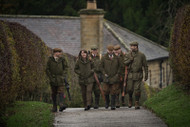10 Key Features of a Shooting Jacket
Posted by Philip Morris and Son on 9th Nov 2023
Shooting jackets are packed with important features; some are essential, and others are down to personal preference. To try and keep this concise for you, we are going to focus here on an absolutely essential list of the top 10 things to check on when buying a new shooting jacket.
1: Waterproof
Most shoots will go ahead no matter what the weather, and being stood for six hours in cold November rain is going to make your day very hard to enjoy. If you’re likely to be out in extreme conditions, check the waterproofing level of the fabric. The fabric should have a rating, which is a pressure measurement in millimetres.
The British standard for waterproofing is just 1,500mm, which is not actually that waterproof. A good waterproof shooting jacket will generally be at least 5,000mm, and top-end fabrics will have a rating above 10,000mm. Also, check that the seams are taped to be waterproof, too!
The waterproof rating of a jacket applies to the fabric layer that makes it waterproof, and often, this is an inner lining. You’ll want to check that the outer lining has what is called a Durable Water Repellency (DWR). This is a coating on the outside which prevents the outer fabric from soaking up water (and therefore getting very heavy) and also aids the breathability of the coat.
2: Breathable
A jacket that is waterproof but not breathable will quickly become very uncomfortable if you are active and generating sweat. On most shooting days, a bit of vigorous walking uphill is fairly common, and if the jacket isn’t sufficiently breathable, it can end up damper inside than out. Again, check out the breathability rating.
A low level of breathability is in the 5,000-10,000g/m2 range and is suitable for less active shooters. For the more active, look for something in the 10,000-15,000g/m2 range. Fabrics of 15,000 and 20,000 plus are available, and if you are very active you might want to look for these. However, for most types of shooting, it isn’t necessary to have a rating this high.

3: Freedom of movement
It’s vital to be able to swing your gun without your jacket restricting you. If it is tight across the shoulders or pulls at the sleeve, you won’t shoot as well as you might. We’ve written an entire blog on getting the fit of your shooting coat correct that you can check out here. The most important point to make is don’t worry about what it looks like, just make sure you can move freely.
4: Pockets
This is down to a personal preference of where you like to keep your cartridges and if you are also picking up or working a dog.
- Bellow pockets of a generous size that can hold at least a box of cartridges are recommendable. They should have a flap to keep water out, and a retaining strap to keep the flap up so you can reload your gun quickly. Draining holes in the bottom is also usual, as there will be wet days when you need to keep the flap up.
- Handwarmer pockets set at lower rib height are ideal for keeping your hands warm whilst resting the gun over your forearm and are a feature of most good shooting jackets.
- A game pocket, either zipped through the rear or on the inside of the jacket, is very useful if you are working with a dog.
- Zipped pocket. Finally, make sure that there is at least one zipped inner pocket for your mobile phone and car keys. We can testify that losing your keys on a day’s shooting has consequences!
5: Sleeve type
This is another area that is all about personal preference. You want a secure fit so the sleeve isn’t coming down as you raise the gun.
A lot of jackets have either a popper or Velcro fit adjuster on the outside. Some also have an elasticated inner cuff, which tends to be a bit of a Marmite thing. The elasticated inner is great for keeping in heat, but many wearers find it irritating.

6: Insulation
It’s important to get the level of insulation right so you get the maximum use out of your jacket. With milder winters in recent years, there is a strong trend towards lighter-weight jackets with minimal insulations, under which you can layer up on a cold day. However, if you are someone who feels the cold or is a less active shooter, then an insulated lining is a good idea.
7: Weight
Historically, shooting jackets were big, heavy garments (especially the tweed ones) that weighed you down, and by the end of the day, you’d be glad to get out of the jacket. However, fabrics have evolved enormously in recent years, and you can now get very light fabrics without compromising performance and durability.
If you’re a very active shooter covering a lot of ground, you’ll want to consider a lighter-weight coat. It’s now possible to get smart, full-featured shooting jackets, such as the Harkila Orton Tech jacket, that are less than 1kg and pack into their own pocket.
8: Durability
Depending on the type of shooting and terrain, you’ll need to think about durability. Rough shooting tends to involve trampling through trees and brambles, and you don’t want your nice new jacket getting ruined the first time you wear it.
Alternatively, if you are a standing gun in an open country, this may be less of a factor for you. It used to be that heavier fabrics and tweed were best if you needed a really tough garment, but it is now possible to get lightweight technical garments like the Schoffel Ptarmigan Evo, which are both light and very tough.

9: Hood
A lot of people hate hoods on their shooting jackets, which flap around in the way, but equally really appreciate them on a very wet, miserable day. It's good always to make sure your jacket has a hood. Most better shooting jackets come with a hood, and, if you are someone who doesn’t like a hood, check that it is either removable or can be securely rolled away into the collar.
10: Drawcords
For both fit and heat retention, drawcords are a great feature. Better jackets often have a cord at both the waist and the bottom hem of the jacket. Adjust both of these correctly, and the jacket will be much smarter and keep you warmer.

